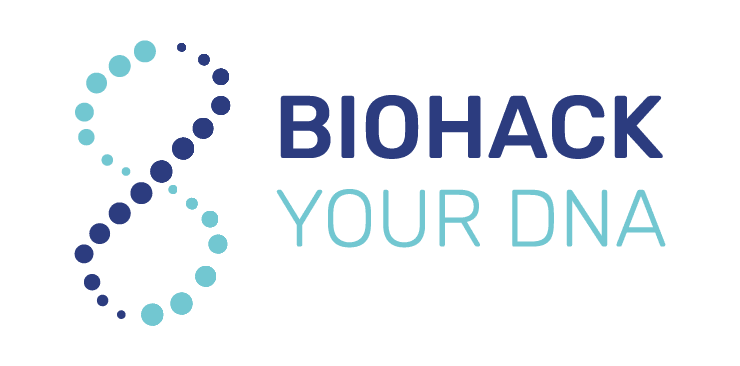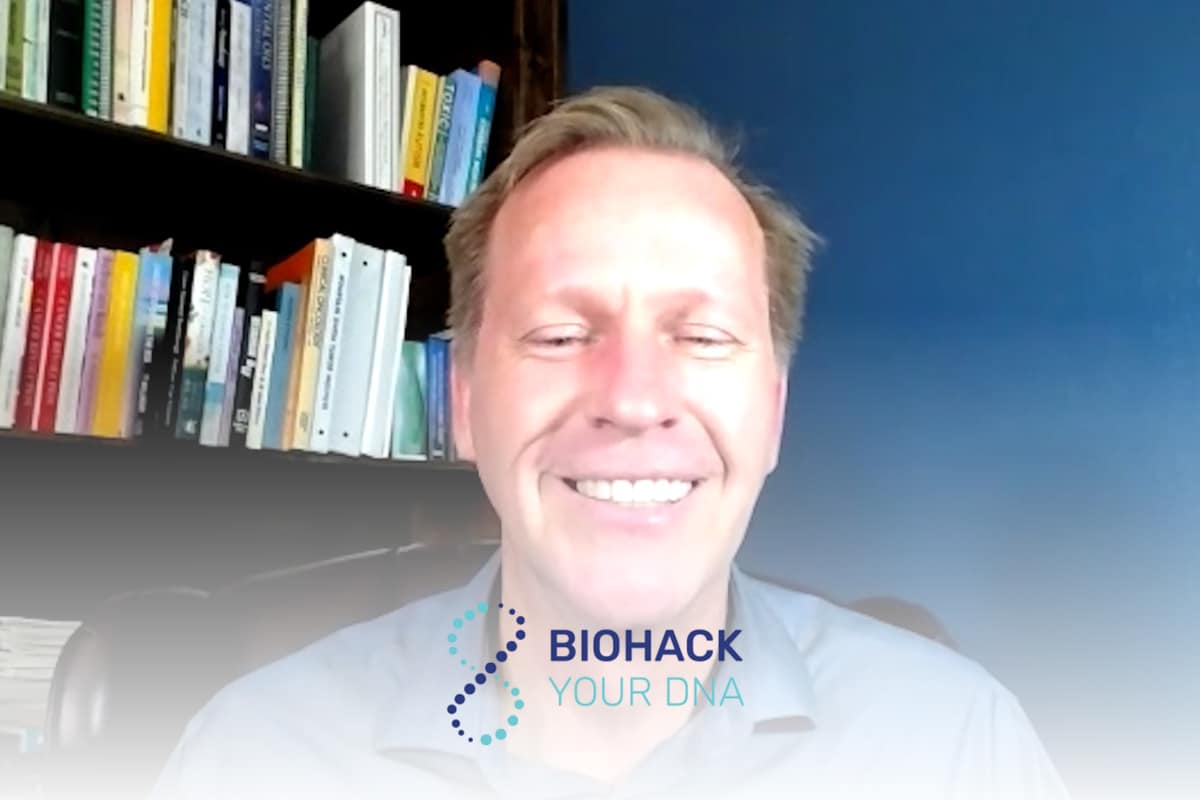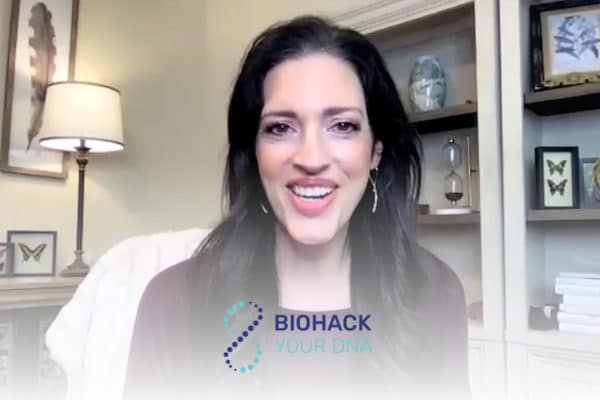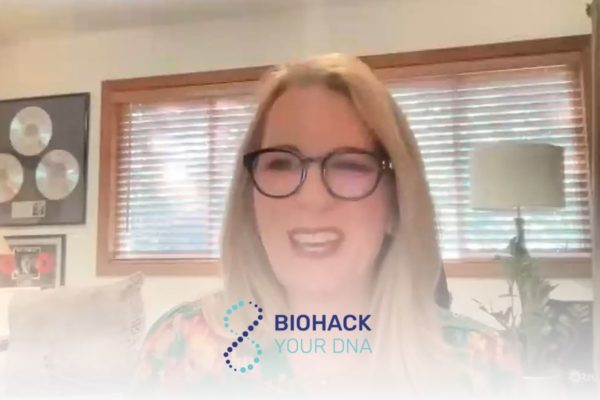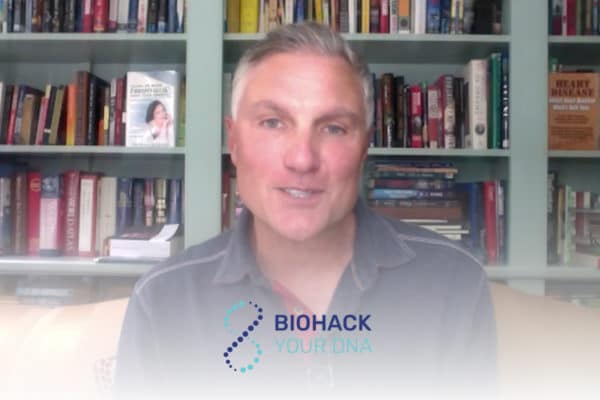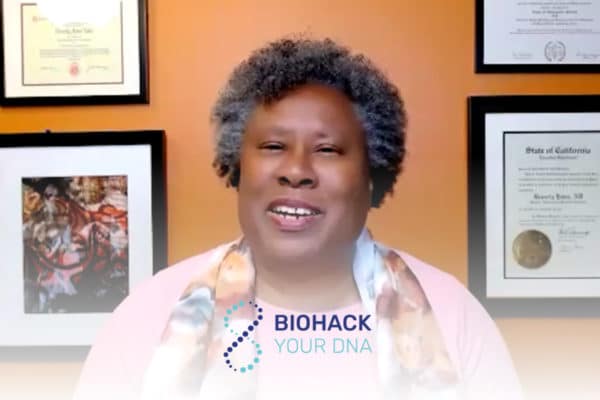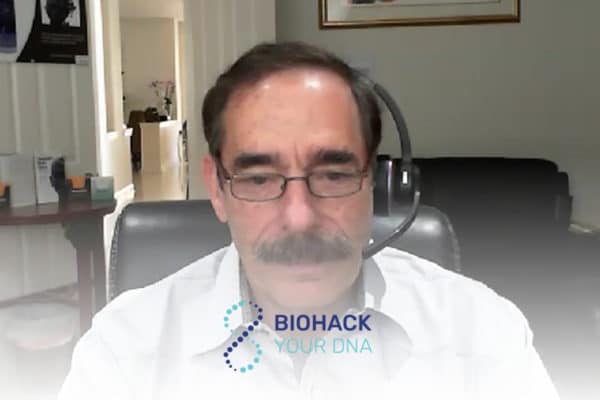Join the discussion below
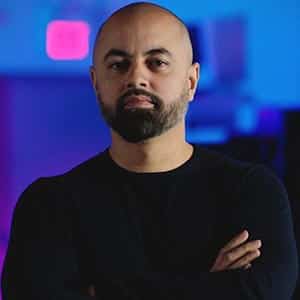
Kashif Khan is the Chief Executive Officer and Founder of The DNA Company, where personalized medicine is being pioneered through unique insights into the human genome. With the largest study of its kind globally, The DNA Company has developed a functional approach to genomic interpretation overlaying environment, nutrition, and lifestyle... Read More
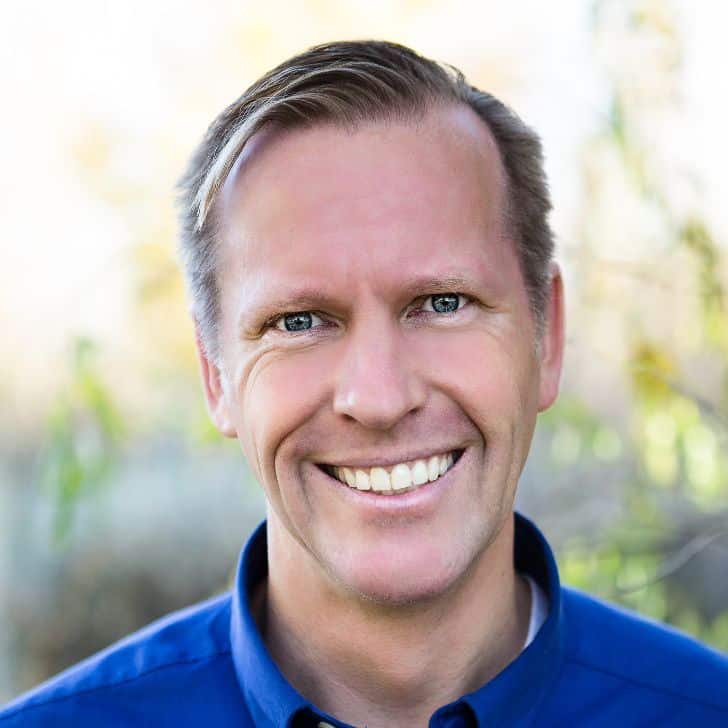
Michael Karlfeldt, ND, PhD, is a Board Certified Naturopath (CTN® ) with expertise in IV Therapy, Applied Psycho Neurobiology, Oxidative Medicine, Naturopathic Oncology, Neural Therapy, Sports Performance, Energy Medicine, Natural Medicine, Nutritional Therapies, Aromatherapy, Auriculotherapy, Reflexology, Autonomic Response Testing (ART) and Anti-Aging Medicine. Dr. Michael Karlfeldt is the host of... Read More
- How to know if you are in an inflammatory state
- Addressing chronic infammation
- The role of the gut in infammation
Related Topics
Adipose Tissue, Aging Theories, Anti-aging, BioHacking, Brain Health, Brain Inflammation, Cardiovascular Disease, Cellular Function, Chronic Inflammation, Cognitive Decline, Dementia, Fueling The Brain, Immune System Function, Immunosenescence, Immunosenescence In Children, Inflammaging, Inflammation, Inflammosenescence, Insulin Resistance, Metabolic Inflammation, Nutrient Utilization, Preventing Aging And Diseases, Senescent Cells, Senescent Cells Clearance, Thymus, Toxic BuildupKashif Khan
All right, everyone. Welcome back. We are gonna dive into a topic that we promised you, and we now found a brilliant mind that can actually break it down and speak to it in the way we need Dr. Michael Karlfeldt is here with us. So first of all, thanks for joining us.
Michael Karlfeldt, N.D., PhD
It’s such a pleasure to be here, thank you so much.
Kashif Khan
And that topic that I’m was referring to is inflammation. And we’ve hear this term being thrown around more recently than before, because we now understand better than ever before what’s going on in the body. And first of all, it’s awesome that you’re here to speak on the topic. I’ve been looking at some of the work you’ve been doing and how relevant it is to this topic. And I think this is gonna be an awesome conversation for everybody, but first of all, for those of us that aren’t familiar, what are we even talking about? What does it mean?
Michael Karlfeldt, N.D., PhD
So, I mean, obviously most of us, we wanna stay young forever, and we wanna have energy. We wanna not be in pain. We wanna have mental acuity. So we try to figure out, you know, what can we do to achieve that? And then we have to look at what are some of the kind of aging theories that are out there. And we are then seeing that inflammation kind of a chronic low grade inflammation is actually one of the biggest drivers that causes us to age. So to look then at what some of these factors are, that’s driving, this inflammation becomes key. And, you know, then you hear, you know, different, you know, weird names and words like senescent cells and right. Inflammosenescence and all that. And we’ll talk about that a little bit later on, but it’s understanding that kinda the importance of addressing some of that chronic low grade inflammation that is different than the acute inflammation that we have when we’re dealing with like, you know, we get an infection or you know, get a trauma, you know, and the body develops inflammation to heal that area. And that’s what’s so exciting, to be able to kind of look at that as one of the driving factors.
Kashif Khan
Yeah, and that’s so important ‘cuz in general, I mean, unless you’re doing the type of work that you’ve been doing, people think about inflammation in the acute context. We all agree that it drives disease, especially chronic diseases. But people think about the last stage, which is what they feel and the pain, and now realize there’s a slow trickle that’s been going on for years and years and years. And you can maybe tackle it a lot earlier. So one thing is that people in general, like I said earlier, tie it to disease, but you’re saying that this is a central hub of aging in general. So how do you separate the two, like there’s aging and there’s disease. Why do you separate that and speak about that in its own silo.
Michael Karlfeldt, N.D., PhD
So they’re actually looking at, you know, so we something’s called metabolic inflammation as well, meta inflammation. And we’re thinking of these diseases like cardiovascular disease, you know, a gain of adipose tissue. You know, we’re getting fatter, our heart’s getting worse, you know, we getting insulin resistant and all these things and they’re actually seeing that those kind of patterns are directly related to aging, you know, that kind of chronic inflammatory. So if you see somebody dealing with these age related diseases and that’s actually the same kind of process that we see in inflammaging.
And so the key is, and that, you know, as we get older, we think, well, you know, I am older, so I’m supposed to hurt, you know, I’m supposed to have lower energy. I’m supposed to not be able to function, you know, or think as clearly as I used to. And that is not true. You know, all these are signs of disease, you know, so aging is actually something that is, is like a disease that is preventable. And if you look at what some of the underlying factors are, that’s driving this process, you can then take very appropriate steps to reduce that risk and reduce that disease that you know, that I would call, you know, inflammaging or aging, you know, due to chronic low grade inflammation.
Kashif Khan
So let’s take one area, say the brain because people that, if you ask anybody about aging, the number one thing they fear is typically Alzheimer’s and dementia. Like I just don’t want to go down that road. Right, as a typical fear. So when you talk about it in terms of cognitive, are these things reversible, like when you’ve, you’ve aged your brain because of inflammation, have you caused damage or is it more like you’ve put yourself down the wrong path and let’s make an adjustment.
Michael Karlfeldt, N.D., PhD
So you have then kind of inflammatory patterns that take place. And when you trigger that inflammation within the brain, that will then impact your body. Or your brain’s ability to utilize nutrients, to burn energy. And especially if you have a lot of toxic buildup in the brain, which frequently happens, if you have poor sleeping habits, and if you have poor circulation, you don’t move and you don’t supply it with the nutrients that it need to be able to function. Then we are naturally going to have a slower functioning brain. And if you kinda look upon it like a car, you know, if you don’t give your car, the fuel that it needs, it’s not gonna drive as fast. And so is it because the car is having an issue?
No, it’s because of the fuel and, and how you are supporting the function of that car. So it’s the same with the brain, you know, we may feel like we are slowing down, but in reality it is that we’re not supporting the brain appropriately and we’re allowing things to take place. That’s triggering that inflammation. So if we then reverse that process and address that inflammation and remove the toxic debris, that’s interfering with cellular function for the energy production within the brain cells. And we also support the repair, then bringing oxygen to that area, bringing that ATP. Then our brain is going then to reverse and function much better and heal better, and we’re gonna have much better acuity.
Kashif Khan
So in all of what you’re describing, I guess it would make sense that the earlier you start the better, right.
Michael Karlfeldt, N.D., PhD
Absolutely, yeah, absolutely.
Kashif Khan
And I think the trickier, the tricky part about that statement is the earlier you start, the harder it is to even recognize that there is inflammation. So how are there tools that people can, people that maybe don’t have a problem that just want to get ahead of things? How would they know?
Michael Karlfeldt, N.D., PhD
So I think it’s important to understand also, when we look at these kinda what’s called immunosenescence, you know, immunosenescence. So we will now I’m bringing in those tricky terms. So let’s define a senescent cells. So this is kind of a cool new understanding of what’s going on in the body. So you have a cell that’s dividing and it has a certain limit as to how many times that it can divide. And they kind of found that as rate limited at, you know, 50 times. So what happens then is after it’s kinda reached that 50 times, and it’s not being cleared off, it is then considered a senescent cell and that senescent cell. It’s secreting all these different chemicals that, you know, these kind of inflammatory chemicals. So in order to be able to clear these cells off, we need a strong, healthy immune system. And that, you know, now we’re looking at the thymus as being one of the very important factors because it helps a lot of the immune system cells are matured in the thymus and these stem cells helps to clear out these senescent cells that should have been cleared out, you know, they call them almost like zombie cells, you know, it’s like, right, living dead cells, they’re just there.
And they’re just spewing inflammatory signals all over the place, creating inflammation, wherever they go in the brain and the cardiovascular in the joints, you know, wherever that is. So thymus becomes a really important in order to be able, are a health immune system. And thymus becomes really important to be able to clear this out. And what they’ve seen is that, you know, we need a healthy thymus to, you know, as we get up to our twenties, you know, our, you know, immune system functions like at a peak, you know, because we’re supposed to survive to childbearing age and we’re supposed to be able to fight the tiger so we can, you know, give food to our wife and also our children. And then, you know, once we fulfill that purpose and we’ve kinda lost our purpose. So then the immune system functions start to go down by the time, you know, we hit a complete low by the, you know, time we’re, you know, 40, 50, and then it’s just kind of bottom and we’re just degenerating. But what they’re seeing nowadays is that even at 12 years old, they’re seeing immune system function to be, to be decreased, what they call immunosenescence, which means that your immune system is dysfunctional and is not able to clear out these zombie cells, that spew out inflammatory chemicals.
So it used to be that by, you know, 20, we wanna make sure we support on the immune system. And by 40, we hit that kind of complete low, where we’re able to clear out these, unwanted inflammatory cells that just can hang out, but now they’re seeing even at the age of 12. Yeah. So it becomes that we almost have to start at our children, you know, right at the time, you know, and support their immune system almost immediately. And so we kinda set up that generation for being able to prevent aging and also the different health diseases or different, diseases that come along with it, like diabetes, like cardiovascular, like cancer, like arthritis, RA, lupus, autoimmune, all of those things. So you gotta start early. I mean, it’s like right now is the time.
Kashif Khan
So this fascinating, because, so in some of the research we’ve done, we found there’s a gene called FOX03, which is just correlated to centenarians, people that live 100 plus because they do such a good job of all of what you described of eliminating senescent cell cell reproduction, stem cell production, you know, essentially that what we do as humans, they just do a lot more efficiently. And so they’re kind of staying ahead of aging better than a typical person does. Then you fast forward to today where you’re saying the reverse is happening that 12 year old kids, you know, put it empirically on paper, look like they’re 40 or 50 in terms of their cell. So my question to that is have the kids changed or is it environmental toxins, or what’s going on, that would cause this, you know, phenomenon.
Michael Karlfeldt, N.D., PhD
So you have all these, different drivers that can then push a cell to become senescent. You know, so, we also have, like in aging, we have, you know, the telomeres, you know, that are kind of the end caps of your genes. And as we age, you know, these telomeres, you know, they get broken up and they get shorter and shorter until, you know, there’s almost nothing there. And then they become very genetically vulnerable, you know, to, you know, you don’t have that protection of the telomeres on the endcap. So they become very genetically vulnerable and then can, you know, and mutate and, you know, and the protein, you know, tissue, regeneration, all of that becomes completely, you know, faulty. And then they can turn cancerous and all these different things can happen. And so you’re seeing them that there’s certain drivers that push, you know, that rapid telomere breakdown and also pushing the cell then to become, you know, senescent.
So when the telomeres are very short and the cell stops dividing, and it’s kind of stuck in that frozen state where, you know, the body’s not clearing it out and it’s just, you know, causing all those inflammatory chemicals to be secreted, you know, than it is in that senescent state. So things like stress, trauma, chemicals, heavy metals, pathogens, all of these things, 5G, lack of sleep, poor nutrition, all of these things will then speed up the breakdown of the telomeres and more rapidly then push that cell into becoming senescent. And what’s fascinating is that these senescent cells, so they’ve done studies that they, they take senescent cells from an old mouse and then put it into a, you know, vital young mouse. And they see that by doing that, that young mouse then start to then develop these, you know, like cardiovascular, diabetes, all these age related diseases or cancer, you know, so that, that senescent, inflammatory signaling is really kind of kicking in.
So we are seeing then that, you know, when, when even somebody that’s young and vital and they have that influx of senescent cells, you know, that’s impacting them. So what they’ve seen then is that a mother that is pregnant with a child, they’ve able to see that the senescent cells from the mother can then pass, go into the placenta and impact the child. So the process can even start to take place when the child is young. So it is really, yeah, it’s really, really important then to address it from this whole, I mean, when you’re getting ready to bear child, I mean, get ready for it and
Kashif Khan
Yeah
Michael Karlfeldt, N.D., PhD
Yeah.
Kashif Khan
There’s a couple of, yeah, I’ve been, you know, looking at your work and there’s a couple of unique concepts you talk about, and one is looking at cell debris and circulating of, you know, mitochondrial DNA. So how is that related to all this and why do we need to know?
Michael Karlfeldt, N.D., PhD
So, yeah, so one of the important things, I mean, a couple of things that I’m really passionate about is a regenerative medicine and then also integrative cancer therapies. And the reason why these relate to each other is that the best way to prevent things like cancer is by supporting regenerative medicine. And you have them, the mitochondria as a core component in cellular function. You know, that is where you produce energy. The mitochondria is the one that supports your genes ability to be able to repair itself. If the mitochondria is dysfunctional, then the gene is not able. The gene in itself, the DNA becomes dysfunctional. And then, you know, how we repair our body then becomes dysfunctional as well and so forth. So the mitochondria becomes a key.
So if we don’t support the mitochondria and, and give it the nutrients that it needs in order to be able to function appropriately, then in itself, then start to oxidize and then start to die and break up. And then you have cellular debris of that that gets into the cell within, in itself, but then also outside of the cell. So then the immune system, when I look at this debris and create then an immune response to that, which can then lead to then odd inflammatory conditions, you know, like, you know, we’re talking about inflammaging, but also then like autoimmune conditions, and then also drive the body towards things like cancer. So to be able to then support the health of the mitochondria becomes key, and also to be able to then clear out on the unwanted debris that’s circulating within the cell to clean that up.
And then also to be able to clean that out in the, in the environment and the body overall becomes key. And there you have, you look at, you know, different processes like atophagy and then also obviously just a cellular or detoxification throughout, you know, the atophagy is that when a cell is too dysfunctional, you know, the cell should break down and die. And then we should be able to kind of clear out that debris efficiently, you know, throughout the body, by supporting your eliminatory pathways, you know, which is how we detoxify and how we clean things out. So, you know, our body can function optimally.
Kashif Khan
Cool. Another area where I saw you have some unique insights in terms of the gut, this is a place where we have a challenge because everybody knows that they should be looking at their gut, but nobody knows what to look at. Right? So the technology that we have is sort of in development for the most part, especially when it comes to sequencing, they’ve got microbiome and there’s some useful stuff there, and there’s some stuff that is novel and needs work. And so when it comes to this thing that we know, we gotta focus on the gut and it’s the source of so much, what do we do and where do we start?
Michael Karlfeldt, N.D., PhD
So it’s interesting. There are a number of things that we can look at in regards to the gut. I mean, frequently patients come in and they they’ve had like a stool test, you know, to see,
Kashif Khan
Right.
Michael Karlfeldt, N.D., PhD
You know, what kind of bacteria or parasites or fungus, or, you know, lack of good bacteria that’s in there not recognizing that, you know, whatever is, is kind of coming out in that stool may or may not be a reflection what’s going on in the whole intestinal track. I mean, ‘cuz you have the small intestines is, you know, 20 some feet long and the colon is only like six feet long. So, you know, and what is then coming into the stool may not be, you know, reflective of what’s going on higher up. And then also if you do like a colonoscopy, I mean now you’re only seeing, you know, in the colon or endoscopy, when you go down with the scope to see, you know, kind of the upper stomach and upper smaller intestines. And so there’s really no good way of scoping all of that, you know? So now you wanna look at, you know, what is triggering inflammation, you know, is there an inflammatory process?
Is there a inflammatory process going along around the gut, you know, are there different kind of bacterial what’s called LPs, you know, bacterial kind of byproduct that’s in the bloodstream that the immune system is reacting to. So you almost have to look at it from several angles at the same time, but when it comes then to aging, you know, the inflammaging that we’re talking about, you know, the gut dysbiosis becomes such a key. So then you have to start, you know, going through the basics, you know, first obviously you gotta poop. I mean, if you don’t poop, then where does it go? And so I had one patient, it was fascinating first time when I saw her, she was dealing with, you know, menstrual issues and, you know, headaches, fatigue, and you know, and yeah, she, she was just not feeling good. So I asked her, you know, so how often do you poop? And she said, oh regularly and well, so how often is that? And she said, well, every time I have a period, I poop.
Kashif Khan
Whoa.
Michael Karlfeldt, N.D., PhD
So obviously that is not normal. I mean the normal should actually be, you eat you poop, you know, so normal is actually three times a day and which in today’s society, that becomes harder. So yeah, we wanna make sure that, you know, we have frequent bowel movements, you know, and that’s a good stool. So you gotta observe, you know, what does your bowel movement look like? You know, how frequent is it, gotta look at symptom wise, You know, do I feel bloated after eating? Do I have gas coming up, acid reflux, heartburn? You know, so you, go through kind of do an analysis as to how you respond and in regards to food. So that’s kind of step number one, and then you can analyze and see, you know, what are some of the foods that may be triggering some of the effects that I’m having? You know, I’m eating. And then maybe I feel like brain fatigue, or maybe my joints are sore, or I just, I just don’t feel good.
So then you can go through and do like an eliminatory diet and you start with a very basic foods such as start with, and then you just add foods gradually and seeing how your body response to that. So that’s a good way of doing that. You can also then do, you know, like I said, a certain blood test where you can then test and see what antibody responses do I have to certain foods, but they are not a be all end all, you know, there are just because it’s showing negative to like gluten doesn’t mean that you may not be reactive to gluten, you know, just because you’re not celiac doesn’t mean that you’re not reacting to gluten. So it’s important to look at your symptoms in addition to your labs, in order to be able to, to determine what’s going on. And then you just kind of step by step, you know, am I producing enough hydrochloric acid? So there are certain tests you can do for that. Is my pancreas supporting a sufficient amount of digestive enzymes? My liver, you know, is flowing enough bile to be able to digest the food.
So all these things are actually key components in order to be able to then set up, then what’s going on in the rest of the gut. And like you mentioned, the gut is such a key when it comes to aging, because there’s so much inflammatory signals that are being sent from the gut when the gut is not healthy, that is an impacting organs all over the place. So that becomes like the foundation whenever you’re dealing with with aging and inflammaging. And in inflammaging, I mean, you wanna look at the gut, you wanna look at your immune system, you want to look at, you know, am I coagulating too fast? I mean, how’s my circulation, you know, you also wanna look at, yeah, am I able to clean out the toxins in my body? So it’s a bunch of cell debris floating around and also then looking at the cells in essence, I mean, am I having these inflammatory signals are being sent all the time? So that’s kind of like the five key pillars that you wanna look at when you look at in inflammaging and you know, like you pointed at, you know, gut is crucial.
Kashif Khan
That’s what you just laid out there is awesome because nobody really speaks about a toolkit or game plan for inflammaging. We all know it’s something to look at, but you’ve laid out look at these five areas and you really have a pretty astute map in terms of where you’re at and what action to take, ‘cuz that’s the challenge. What do I do? Where do I start? Right? And until you’ve measured something, but most people don’t know what to measure. So with the senescent cells, you are saying that you’re using inflammatory markers to try and predict where people are at.
Michael Karlfeldt, N.D., PhD
Yes, yeah. So there’s really no, you know, total, I mean there’s really no full test to check for senescent cells, but there are some tests that you can check to see inflammation wise where you’re at. So common ones are like C reactive protein. Yeah. And then also you have your sed rate is a good factor. You also look at, you know, Ferritin levels, fibrinogen levels, you know, so these are good kind of inflammatory markers to look at, but then also there’s a test that I use at my center. It actually checks your, your urine for Thromboxane, Thromboxane two. And that’s a fantastic test to kind of check for overall inflammation. And with that, then you can then monitor and see. So I have a baseline that this is where I’m at right now, right? And it gives you a number from zero to, you know, several thousands. And it’s interesting to me as I’m working with like cancer patients, for instance, seeing when, when their cancer is going then into, you know, becoming more active and seeing that number increase and it’s less active that number decrease.
So it directly correlates with kind of the overall inflammatory processes that goes on in the body. And it’s a very simple test. And then you, so you do a baseline and then you introduce a therapy, whether you’re bringing in Quercetin, which is known what’s called a senolytic, you know, which will then break down a lot of these senescent cells or curcumin or fisetin or, you know, these fantastic, you know, supplements that are kind of help to reduce inflammation Boswellia, or Frankincense, another name for it. So then you introduce a therapy after you’ve had a baseline and then you retest and see, am I making progress or am I not making progress? And if I’m not making progress, what other things do I need to change? And it’s always good to go back to the basics, you know, in regards to how to address your health. So you were talking about, you know, the centenarians, you know, and the blue zones and the kind of habits that they have. And these are very basic habits that becomes really important.
And you gotta have that foundation, I mean, we do, you know, peptides and ozone therapy and intravenous laser therapy and all these curcumin IVs and all, I mean, we do all those things at our center, but you need to have that foundation in order to be able to build upon. And that foundation, you know, is, you know, you look at the habits at these kind of blue zone people like in Italy and Greece and Japan. And, I can’t remember, I think it’s Costa Rica as the other is the fourth one that they look at and it’s having a purpose, you know, living a meaningful life, you know, having community, slower pace, eating, you know, a diverse diet, you know, that is, you know, plant based and nutrition dense and moving.
Yeah, they’re not really exercising or, you know, going to the gym, you know, but they’re moving and they’re doing their chores and you know, so they’re always active. So this is kinda like a foundation. And then you can build upon that with all these other cool things that you can do, like the senolytics or, you know, bringing in, you know, turning on the ATP using then intravenous laser external laser, or, you know, bringing in oxygen therapies. Like, you know, we do a therapy where you, in essence, you know, blood goes out from one arm, it gets ozonated in the machine and it goes into the other arm and that will help to bring down and get rid of all these kinda senescent cells and reduce inflammation, turn on ATP you know, so you can bring all that in as long as you make sure you do the foundation first.
Kashif Khan
Mm, yeah. I like the way you separated things where there’s all the activity that kind of fuels the fire, right?
Michael Karlfeldt, N.D., PhD
Yeah.
Kashif Khan
And you gotta remove all that and replace it with habits that don’t then go ahead into the therapeutics of, for example, some of the regenerative tactics you have and, you know, products that you offer, but if you’re not stopping, fueling the fire and you’re doing these things to mask your pain point, how different is that from any other, you know, symptom masking sick care model, right? You’re you’re yeah, for sure. You might feel better on that day, but if you’re still exposed to the toxin, the whatever it is, that’s causing you your issue. So that’s a very smart delineation. You gotta deal with both. Yeah, so in your work with regenerative medicine, what is a intravenous laser? This is the first time I’ve heard that term. I thought I knew a lot, but first of all, how do you even get a laser intravenously into somebody is just blowing my mind right now.
Michael Karlfeldt, N.D., PhD
Yeah, it’s pretty cool, actually. So it’s a therapy it’s called photobiomodulation and, and that doesn’t mean that, you know, it’s intravenous, you can do that anywhere, it can do that external, but photobiomodulation just means that you use light to create changes, you know, within your body. And it’s a really fascinating, you know, therapy. Michael Hamlin, I had a chance to interview him on my radio show. He’s one of the leaders in the world and in the research in regards to photobiomodulation using light to turn on the mitochondria, to trigger the release of nitrous oxide, to slow down aging, to regenerate cells and to heal people dealing with Parkinson’s. And so it’s a really cool therapy. So what we have then at our center is that there’s a machine, so you can actually do an optic cable that you thread them through the needle, you know, that you insert intravenously.
Kashif Khan
Hmm.
Michael Karlfeldt, N.D., PhD
And so what happens then and, that optic cable then will then obviously it will light up the vein and you can,
Kashif Khan
Wow.
Michael Karlfeldt, N.D., PhD
Connect that to different colors. So we have several different colors. You have like ultraviolet, you have blue, you have green, yellow, red, and infrared, and each color, they have different functions in the body. And so you can then as a blood then passes by that optic needle or that optic fiber that’s in that needle, you know, that blood gets treated, which means that at every point every minute, you know, the blood will then pass by that point.
Kashif Khan
Right.
Michael Karlfeldt, N.D., PhD
And so in a session for like 60 minutes, you know, your whole blood volume gets treated 60 times, which is pretty phenomenal cause you,
Kashif Khan
That’s incredible.
Michael Karlfeldt, N.D., PhD
Yeah the other therapies that’s existed in the past, you know, one is called UBI or ultraviolet blood radiation. That’s when you pull, you know, like 60 CC, you know, 60 milliliters of a person’s blood, put it in a saline bag and then you put ozone into it and then you run that through an ultra and a machine that irradiates it with ultraviolet light. So now you’re radiating, you know, like 60 CC of your blood, you know, one time and here you’re, you know, you irradiating your whole blood volume, you know, 60 times, you know, so there’s, it’s just like no comparison. And with that, then you, if you’re dealing with pathogens, like, you know, viruses, Lyme, fungus, parasites, or whatever it may be, then you’re then able to, you can use, and what’s called a photosensitizer, you know, that you introduce and a photosensitizer like riboflavin or vitamin B2, you know, would be a common photosensitizer and then an actual attach itself to pathogens or attach itself to like cancer cells. And which means as a photosensitizer will then pull more light towards itself.
So, you know, let’s say that attach itself to like an Epstein Barr virus and then ask, you know, that Epstein Barr virus and get exposed to the light that is directly associated with that photosensitizer so like riboflavin or vitamin B2, it pulls a lot of the blue light, you know, so you would then pair, you know, after doing an intravenously vitamin B2, you would then pair that with blue light intravenously. And so then, you know, when the Epstein Barr then gets, gets kind of blasted over that blue light and has that riboflavin on it, it will then pull all that light and then oxidize and that virus and killing it. So it becomes a really effective way of clearing out pathogens and clearing out unwanted cells and clearing out things like senescent cells and activating the immune system. And, you know, it’s a really cool new therapy that I have been doing a number of years in my clinic.
Kashif Khan
It sounds like there’s a lot of precision to it, and you’re kind of short cutting things and going straight to the source. So I’m assuming that the outcomes are really quick.
Michael Karlfeldt, N.D., PhD
Yeah, it’s really amazing. And then if you combine it with like, you know, like PRP and peptides, like,
Kashif Khan
Right,
Michael Karlfeldt, N.D., PhD
For instance, you know, we do PRP into a joint, you know, platelet rich plasma, which, you know, for listeners out there, you pull blood from the patient, you spin it, collect platelets, which has a lot of growth factors. And you inject that into the area and into the tissue that needs regeneration, you know, then all these growth factors will then be kinda released. And then you can add, you know, peptides, like, you know, BPC157 is a common one, thymosin beta four, you can do, or you can inject that into the location, along with the peptides. And then you can then add then a laser, you can then kinda in particular, you bring that laser into the areas, you know, right. Where the fibers over the joints are and you turn that on. And that will actually activate stem cells by like 20 times, you know?
Kashif Khan
Wow.
Michael Karlfeldt, N.D., PhD
So it really kind of brings everything up to just a completely different level when you bring light in like that.
Kashif Khan
So when does somebody, when does their need graduate from say peptides and exosomes to stem cell treatment? ‘Cause there’s a lot of people that consider things like cost and jurisdiction where to get it done. So who’s that person that needs it.
Michael Karlfeldt, N.D., PhD
So usually, and it’s hard to know actually, I mean, usually what I suggest is that you, you start with like pep, I mean, PRP you start there and peptides, it’s a lower cost, easier to get. And then you see what kind of regeneration you get. And if that does not work, then you can then bring in things like stem cells and to kind of push at, or exosomes stem cells take a little bit longer to regenerate. So usually you don’t see that full effect, you know, within, you know, usually it takes at least about three months, you know, before you really start to see what’s taking place, exosomes, if you want to have kind of a quick results, you know, exosomes will help with that. So frequently, what is done is that you do combination of exosomes and stem cells. And then, so you get that quick repair with exosomes and then also that longer, you know, repair over a longer period of time with stem cells. So, yeah, I mean, we’ve used stem cells in our clinic. It’s been fascinating. I mean, we had, yeah, obviously for joint regeneration, it is tremendous what you can do with that.
But also then, you know, when we’re able to do it like intravenously, you know, seeing had a elderly lady, she was in her eighties, you know, dealing with stage five kidney disease and she didn’t want to go on dialysis. You know, she felt she was too old and too tired to do that, you know, so, and the doctor gave her like I think it was like two to three months left to live, you know, if she didn’t do anything, I mean, her kidney numbers were really, really poor. So she chose to come to our center and, and did then in combination with stem cell IV, we did then intravenous laser therapy, nutritional therapies, hyperbaric oxygen therapy, really to kind of juice up the activity of these stem cells to really kind maximize effect of them and her numbers, you know, jump from, you know, low teens, you know, I think it was like 11 or 12 or something like that to, you know, now it’s in the high 40, 50, and it’s been like that for a number of years and she’s doing great. So yeah, it’s really amazing to see what you can do with regenerative medicine when you introduce these type of things, and the key is just to kind of support the body’s own healing mechanism. I’m just kind of giving it what it needs, you know, the basics, oxygen, light, nutrients, and then you kind of bring in some youthful stem cells.
Kashif Khan
Yeah, for sure. And what a blessing that she was able to find you, ‘cuz so many people will never hear in their lifetime, at least today that things like this even exist, you know, and it’s unfortunate, but I believe the future is this will become common practice as it’s undeniably a path we need to go, you know, stories like that, that I hear. I wonder how do people find somebody like you, like where do they eventually get to this place where I need to go to your center?
Michael Karlfeldt, N.D., PhD
Well, and I obviously first an individual has to be aware of what is possible and what is available in order to be able to know what to look, you know, look for. You know, I’ve been doing this for 30 some years and, and I’m really big into education. That’s why, you know, I have a couple of podcasts, have radio show, a TV show then that I ran for a number of years over on Amazon prime. So to me, education becomes key. And I think, and that is, what’s so amazing with these kind of summits and what we’re doing right now is just to allow or to kind have the public know of what is possible, what exists out there. And what’s exciting with regenerative medicine is that it is escalating or, I mean, it it’s accelerating quickly as to what we can do in order to be able to support the physiology and the function of an individual using these natural, safe therapies. And so it’s an amazing field, really exciting. And I think it’s important for people just to recognize that they don’t need to rely on just symptom management using pharmaceuticals.
There are tools out there that’s available to support the body’s own healing mechanism, you know, but you, you gotta start at the foundation like we discussed before. You also gotta look at, you know, what my ability to, in addition to, you know, working on the gut, you know, how am I detoxifying? Like, you know, the mitochondria exist, you know, within a certain environment, you know, the mitochondria is where, you know, again, we talked about that’s what produce energy and that’s what repairs the cell that’s, you know, that’s what makes you feel good and young and strong, and the mitochondria is dependent on obviously the fluid that’s around it and what exists in it. So if that looks like a dirty fish bowl, you know, that mitochondria is not gonna be happy, if it’s a clean, healthy fish bowl, you know, where the water is clean, lots of nutrients in it, that fish is gonna feel awesome.
And so the key is just, you know, we gotta support detoxification, we gotta control inflammation, we gotta bring in nutrients into the system and we gotta do the different steps that’s needed for a healthy mitochondria to function and oxygen, you know, reduce stress, you know, bring in meditation, you know, bring in all these different things that really, you know, is key for your mitochondria to function well.
Kashif Khan
This is awesome. You know, I think of what you’re discussing now in regenerative medicine, you know, people think of it as like, you know, I have a tear in a muscle or I have joint pain. I’m gonna use this product for like a targeted sort of focused problem pain point. But really we’re talking about, again, both ends, right. Go ahead and do that, but create the terrain, create that environment where the body’s thriving and get the benefit of both yeah. Acutely deal with the problem. But that problem happened because the system that the problem happened within is, was ready for and ripe for problems, right. You gotta first get the system down, like turn the dials down and get everything going properly, which beautiful about the work you do. So if somebody wants to work with you in your center, how do they find you? Where do they go?
Michael Karlfeldt, N.D., PhD
So the best is just to look me up on my website, you know, it’s thekarlfeldtcenter.com, and Karlfeldt is one of those. I mean, yeah, I’m sure you have the spelling here on the interview.
Kashif Khan
Sure.
Michael Karlfeldt, N.D., PhD
Yeah, you can just give us a call. It’s at 208-338-8902, you know, and just schedule and it’s not just myself. We have a bunch of different providers that are incredible, orthopedic doctor, you know, people, you know, doing the regenerative medicine, a bunch of nurses, nutritionist. So we’ve got a whole team and the whole, our desire is to create a place where a person can go, no matter what their need is that we can then a address it there, you know, with really powerful therapies, you know, that does include, you know, peptides, you know, or liquid allographs, stem cells, or know a intravenous nutrition or, you know, laser therapies or hyperbaric oxygen, or ozone, almost like an ozone dialysis where you clean the blood, you know, using ozone and oxygen and yeah. Doing all these things so that a person can feel like they can just kind of step in, hang out and be, you know, and regenerate, you know, in one location.
Kashif Khan
And what city you there in?
Michael Karlfeldt, N.D., PhD
It’s a Meridian Idaho. It’s just outside of Boise. Yeah, so it’s a really cool place to live, but don’t tell anyone.
Kashif Khan
Amazing. Well, I guess I’m planning my next vacation. I’m coming to Idaho gonna get some regenerative treatment and see what’s going on in Boise.
Michael Karlfeldt, N.D., PhD
Yeah, you should come and hang with us. And then obviously, I mean, in your expertise, you know, dealing with, you know, DNA and, you know, how they function optimally, you know, then bringing all these things in to work on the epigenetics, you know,
Kashif Khan
For sure.
Michael Karlfeldt, N.D., PhD
How DNA turn on and turn off, you know, by maximizing your cellular function. That becomes key.
Kashif Khan
Yeah, well, this was incredible. Thank you for, you know, opening up and telling us all about what you do, but really helping us understand what we can do to, you know, tackle inflammaging and just live longer and healthier. This is amazing, thank you.
Michael Karlfeldt, N.D., PhD
Yeah, absolute my pleasure. Yeah, it’s a subject I’m passionate about and everyone should do whatever they can to reduce inflammaging.
Kashif Khan
Awesome, thanks again.
Michael Karlfeldt, N.D., PhD
My pleasure.
Downloads
